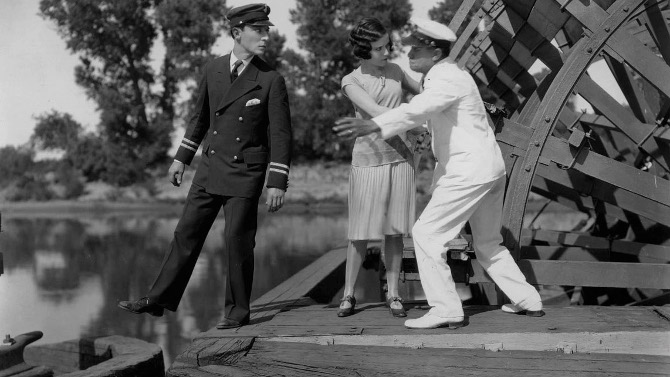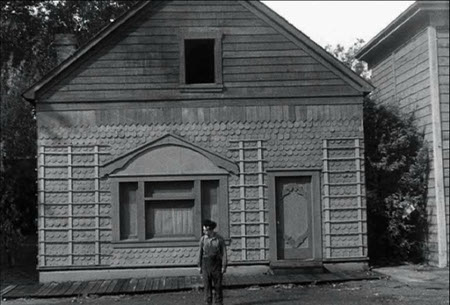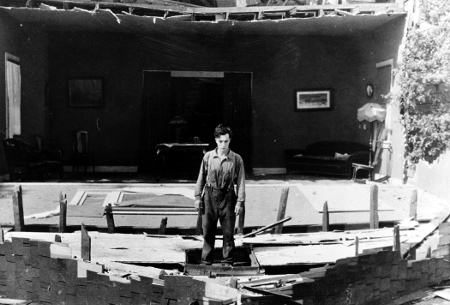An inside joke for fans of Buster Keaton, they surely know that he often wears a pork pie hat in his films. Well, while watching 1928’s Steamboat Bill, Jr., there is a scene where his uncle takes him to buy a new hat – to replace the effeminate French beret that currently adorns his little head. A revolving number are tried on by the young man, with the closest to his original being wholeheartedly rejected. Though he does eventually purchase a much larger version of a pork pie hat, it flies off of his head and into the flowing river, not to be recovered.
This, in many ways, is symbolic of the changing era the talented silent comedian found himself in. After the box office debacle that was The General (now considered one of his greatest features), Keaton was no longer blessed with carte blanche when making his movies – the studio keeping a keen eye on spending and limiting his overall control.
Directed by Charles Reisner and written by Carl Harbaugh, it was actually Keaton who did most of both. With a still healthy budget of four hundred thousand dollars (half of it going to the impressive finale), it turned out to be his biggest box office disaster (despite now being considered a classic) and was the final nail in the coffin of his independent productions with producer Joseph M. Schenck, the end of an era for the creative talent. It led him to signing a contract with MGM, but the strict studio system did not work well with his perfectionist attitude and the freedom Keaton had enjoyed for so very long, and when combined with the coming ‘talkies’, he was never to enjoy the success he once had.
Set on a hip and happening river, William “Steamboat Bill” Canfield (Ernest Torrence) is the gruff owner and captain of a decaying steamboat. A large, feisty man whose livelihood is being threatened by businessman J.J. King (Tom McGuire), who has just brought to town a new, modernized steamboat, Canfield is ecstatic when he learns his son (who he has not seen since he was a little boy) is coming for a visit, as he has just finished his schooling.
Expecting to see a boisterous, larger than life persona, he is disappointed to learn that William Canfield Jr. (Buster Keaton) is a petite, pencil-mustached bookworm and artist, a namby-pamby weakling that does not fit the mould for rugged, working-class water life. Also visiting the locale is King’s daughter, Kitty (Marion Byron), who has long been friends with the younger William.
In many ways a story of star-crossed lovers, the pair are eager to make a connection, but their feuding fathers have other plans, constantly getting in the way of the burgeoning bond. This is no better exemplified than when King tells one of his employees to ban the man from his boat, while his father coaxes him to break that rule (not for love, but to show some toughness) – we see Keaton being pushed back and forth from boat to boat, coming dangerously close to falling into the deep blue each and every time.
Though there are many great moments along the way, it is the mind-boggling finale that makes the film. One of Keaton’s most impressive and daring stunts (and that is saying something), a giant, blustering windstorm hits the town (he built the three block locale for the film) as our protagonist wakes up in a hospital bed. With a surrealist vibe (it almost feels like the tornado scene from The Wizard of Oz), Keaton scurries through the town, battling the gusts that push him all over the place (the wind came from six colossal airplane propellers). In a death defying stunt, Keaton stands still as the two ton wall of a home falls down around him – luckily surviving by fitting perfectly through the uppermost window (he had done the stunt twice before, once in One Week, which was reviewed on Filmizon.com, but neither were done with a full sized wall). With half of the crew walking off set out of fear, Keaton had to hit his mark (a nail in the ground), otherwise he would be crushed to death. As you can guess, it was done in one take, and Keaton later said, “I was mad at the time, or I would never have done the thing”. It shows the daring chances the silent superstars took to entertain their audiences – though it did not help that Keaton had just been told that his studio was being shuttered, making him more reckless than usual. Not to be outdone, another sequence finds an entire house landing over the man (using a mechanical arm for the wholly real stunt), Keaton then walks out the front door, in his typical casual, nonchalant fashion. Not too long later, it splinters apart in the storm. Though, these are not the only two eye-catching moments, there are countless others in these fifteen or so minutes. One of the most comedic finds Keaton attempting to jump a fence to avoid the mayhem, yet the spot he hops over is the door, which swings open – meaning that he has just ended up on the same dangerous side. Running through the now open door, it closes, hammering him back. Magic tricks, a creepy ventriloquist’s dummy, video game-like jumps and dangling water rescues permeate other moments, examples of the superior movement, and likewise, the talented falls that make a Keaton film so enjoyable.
As a sidenote, the water stunts with Keaton and Byron were actually done with Keaton’s sister Louise, as the actress could not swim – you will clearly see them trying to hide her face.
A highly influential film, Steamboat Bill, Jr. inspired Walt Disney’s Steamboat Willie the same year, often considered the debut of Mickey Mouse. More recently, the iconic stunt was tinkered with on the highly regarded series Arrested Development. Mixing a love story with Buster Keaton’s varied jocose set pieces (stoic faced reactions and vaudeville inspired gags, to death defying stunts by land and sea), it is an unbelievable display of comic ingenuity – still utterly impressive approaching its ninetieth anniversary. So, hit your comedic mark by watching this iconic motion picture, it will minister to your funny bone.



